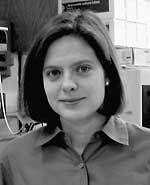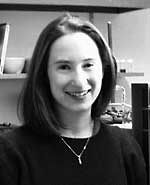Two Department of Chemistry faculty members are among 56 recipients of the 2005 Presidential Early Career Awards for Scientists and Engineers, the nation’s highest honor for professionals at the outset of their independent research careers.

Associate Professor Anna Mapp and Assistant Professor Melanie Sanford were honored July 26 in a White House ceremony presided over by John H. Marburger III, science advisor to the president and director of the White House Office of Science and Technology Policy.
Nine federal departments and agencies annually nominate scientists and engineers whose work shows exceptional promise for leadership at the frontier of scientific knowledge. Participating agencies award these talented researchers up to five years of funding to further their work in support of critical government missions.
Mapp, who was nominated by the National Science Foundation, uses tools of synthetic organic chemistry to create building blocks that when linked adopt some of the forms and functions of proteins. These protein mimics will be more stable than their natural counterparts and can be designed to react in ways that are impossible for actual proteins. The aim of the research is to develop new kinds of molecules that can be used to probe the workings of cells and cellular systems. In addition to her laboratory research, Mapp is exploring new ways to bring greater diversity to the sciences.

Sanford, nominated by the National Institutes of Health, works on developing new ways of putting organic molecules together by using carbon-hydrogen bonds (ubiquitous but notoriously unreactive pieces of organic molecules) as building blocks for chemical synthesis. The techniques that her group is developing should find widespread application in the rapid discovery and optimization of novel pharmaceuticals.
These new procedures also are important from an environmental perspective, as they are designed to use only small, catalytic quantities of toxic reagents and to reduce the number of chemical steps—and, therefore, the amount of waste in terms of solvent, reagents and by-products that form during pharmaceutical syntheses. Sanford’s efforts in mentoring and curriculum development for both undergraduates and graduate students also were recognized in this award.

